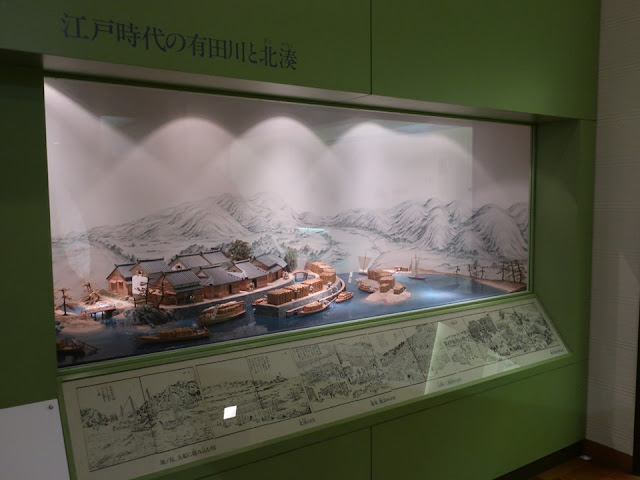Arida city is my home town which is around 90km south of the central Osaka. Arida is at the mouth of the Arida River which flows into the Pacific Ocean. Mandarin orange (mikan) trees are planted on the mountains at the opposite side of the sea; it is one of the main production areas of mandarin orange. I lived there when I was a child.
There are two rooms in the museum; one
is about local history, and another one is about mandarin orange. I took and uploaded photos under the
approval of the museum office.
実は、私の祖父や父が生まれ育った土地、私も四年ほど住んでいました。和歌山県有田市は、有田川の河口でその先は紀伊水道(海)です。海の反対側はみかん山。大阪中心部から90kmほど南、温暖な土地です。
資料館は、郷土資料館の部屋とみかん資料館の部屋に分かれています。資料館の許可を得て撮影、掲載しています。
Local history exhibition room、郷土資料館
The history since the prehistoric age is elaborately explained.
有田の歴史が原始時代から丁寧に説明されています。
Many cultural assets since the medieval era are conserved in the city. Myoe Shonin (holy monk, 1173―1232, lower left) was from Arida. He was famous for spreading tea which came from China. He had trained since 23 to 38 in Arida; the relics remain. I understand how locals respect him.
中世から大切にされている文化財が多いです。特に京都の高山寺を再興した明恵上人(1173―1232、左下)は有田の出身で、上人が23歳から38歳まで修行した遺跡(卒塔婆など)が残っています。明恵上人は、栄西が中国から持ち帰った茶を普及させたことでも有名です。丁度、生誕850年で、「国史跡 明恵紀州遺跡率塔婆保存修理記念企画展」が開催され、遺跡修復の様子が展示されていました。先人を敬う気持ちが強いですね。
The old road to the three grand shrines of Kumano is the integral part of the regional history. More than a hundred of nobles including the emperors went to Kumano with attendants. There are 99 small shrines on the way, and three of them are in Arida. Nobles took a rest there; they prayed, offered the Buddhist sutra and had a poetry party; how graceful they were!
In Muromachi period (1338-1573), many ordinary people pilgrimed to Kumano instead of nobles. It was called “procession of ants to Kumano”.
Reference post: Kumano Nachi Taisha (shrine)、熊野那智大社
熊野古道は紀州の歴史では外せませんね。後白河上皇だけで33回、孫の後鳥羽上皇は29回、百回を越える宮廷人の列が熊野へ向かいました。途中、99の王子社があり、上皇たちはそこで休息し、遙拝や経の供養、更には歌会などを行ったそうです。雅ですねえ。有田市には三つの王子社がありました。室町時代になると、宮廷人の行幸は衰えて、「蟻の熊野詣」といわれた庶民信仰が盛んになりました。古文書が展示されています。
The cormorant fishing (ukai, a bird catches a fish) is introduced here. It initiated around five hundred years ago. The local lord invited a ukai master (usho) from the Kiso River area in central Japan. Ukai fishing is rather like an entertainment than livelihood. Many tourists see the event. Therefore, I guess the lord wanted to entertain his guests.
Reference post: Nagaragawa Ukai Museum、長良川うかいミュージアム
At the Arida River, usho walk into the river (don’t use a boat), control his cormorant and catch ayu fish. They catch a cormorant in spring, train it and return it to the sea in autumn (after the fishing season). It’s a sad farewell, I’m sure.
有田川の鵜飼も紹介されています。歴史は古く、500年前に鳥屋(とや)城主が木曽川から鵜匠を招いて始めました。鵜飼は、もともと漁よりもパフォーマンスの意味合いが強いので、城主の接待用だったかも知れません。
ところで、有田川の鵜飼は、鵜匠が徒歩で川に入る徒使い。鮎との距離も近いです。そして、春先に海で鵜を捕まえて調教し、鮎狩りのシーズンが終わる秋に海へ返します。名残惜しいでしょうね。
The attractive man at the Edo period (1603~1868) section is Kinokuniya Bunzaemon. He was a logistics provider and a trader of mandarin orange. Although he is famous as a billionaire, it is written that some topics are just legend and the truth is unclear.
The first daimyo
lord of the region (Tokugawa Yorinobu, 1602-1671,
he was a cousin of the shogun) not
only encouraged planting mandarin orange but also developed a port (Yabitsu
port). People there have an anniversary event of his death even until now. It’s
an ideal relationship between lord and residents. Btw, the ceramics in front of
the picture has a story.
江戸時代のコーナーの大きな絵は紀伊国屋文左衛門です。元禄時代に、みかん船で巨利を得て、豪商になったということですが、「半ば伝説化され、確かなところは不明である」と書かれていました。
初代紀州藩主の徳川頼宣は、みかんの栽培を奨励しただけでなく、矢櫃浦の開拓もしました。矢櫃では、今も頼宣の命日(逮夜)に日待を行っています。領主と領民に良い関係があります。意外だったのは、左下の陶器類。
Arida farmers purchased ceramics of Imari in Kyusyu in the agricultural off-season, and sold them in Edo (old name of Tokyo). After they were prohibited to sell them to the customers directly in 1723, they sold them to the wholesalers. The lord supported them by collecting sales proceeds, using his brand and so on.
The wooded tags certificated that they were official merchants of the lord. While vending ceramics, tags worked well; because people across Japan paid respect to the merchants. The ceramics were wrapped by straw which is sustainable material (lower right).
有田の人々は農閑期に伊万里で陶器(有田焼)を仕入れ、江戸で販売しました。1723年に直売が禁止された後は、瀬戸物問屋が販売をしますが、「紀州藩の御蔵物の名称を使用することや売上金の回収など、みかんと同様に紀州藩の威光を有利に受けました」と書かれています。また、「紀州陶器方」という鑑札を腰に吊して行商すると各地で大変な敬意を払われました。藁が梱包に使われました(右下)。
Mandarin orange exhibition room、みかん資料館
Mandarin orange is a specialty of Arida. The fruits were already shipped to Kyoto, Osaka and so on in around 1600. In 1634, they were shipped to Edo and it became the major industry of Arida.
みかんは熊本の八代から来たとも、この地に自生していたともいわれています。1600年ごろには大阪や京都、1634年には江戸へも出荷され有田の一大産業になりました。
The fruits were transported to Osaka by ship until early 20th century; it was my grandpa’s work. He had a sailing ship and hired young men.
みかんを木箱へ入れて船で大阪まで運んでいた時代(大正期まで)。私の祖父の仕事でした。帆船で若い衆を雇っていたと聞いています。
The fruits were transported by train in the 20th century. There are lots of wooden boxes of fruits at the station. It’s lively!
鉄道で出荷した大正から昭和期。有田の中心、箕島駅に活気がありますね。木箱が山積みです。
The photo above shows the boxes for transportation. Mandarin oranges are packed into cardboard boxes and are transported by trucks nowadays.
みかんを運んでいた木箱。その前は籠でした。今は、段ボールに入れてトラック輸送です。
The ship “Bezaisen” carried the fruits to Edo (Tokyo). It took only three or four days to reach Edo if it was a fair wind all the time. Edo people enjoyed the taste and loved them.
江戸時代にみかんを運んだ弁財船、順風なら3~4日で江戸に着きました。江戸の人々が舌鼓を打ったということです。
The fruits shipped from the port “Kita-minato” at the mouth of the Arida River. It prospered so much.
有田川河口の北湊。みかんの出荷場所です。こんなににぎわっていたなんて。
The Arida River is in front of the museum, which is at the fourth floor of “Arida city bunka (culture) and fukushi (welfare) center” (upper left). There are mountains at the opposite side of the river, and Minoshima station is just 200m away from the building.
資料館の前の有田川。資料館は箕島駅の近く、有田市文化福祉センター(左上)の4階にあります。
The slopes of the mountains are steep and have orange plantations. There are farm stands of orange along the national road. I well understand that my ancestors had lived at the limited in the flatland and had created their industry and culture.
山側は急斜面のみかん畑、国道42号線沿いには直売所があります。私の先祖たちが、限られた平地で、生活を営んできたことがよく分かりました。
Official website: https://www.city.arida.lg.jp/kurashi/sportsbunka/bunka/1000924/index.html
(in Japanese), accessed in November, 2023
Visited in
March, 2023
Previous post (museum in the neighboring town, the building is an ex-public
bathhouse): Jin-Buro
Museum in Yuasa town、甚風呂(銭湯跡歴史資料館)と湯浅町(和歌山県)
Next post (museum in the neighboring city): Uruwashi-Kan(Traditional Kishu Lacquerware Industry Center)、紀州漆器伝統産業館 うるわし館














Comments
Post a Comment